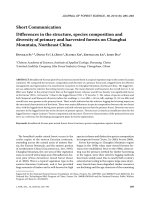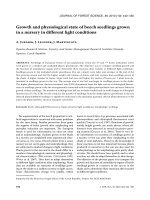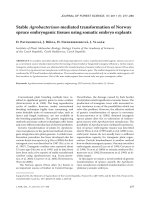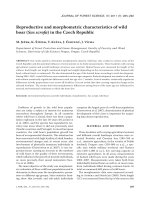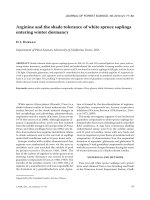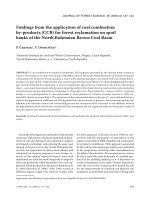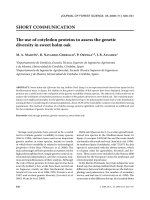Báo cáo lâm nghiệp: "SHORT COMMUNICATION The use of cotyledon proteins to assess the genetic diversity in sweet holm oak" potx
Bạn đang xem bản rút gọn của tài liệu. Xem và tải ngay bản đầy đủ của tài liệu tại đây (241.71 KB, 6 trang )
526 J. FOR. SCI., 55, 2009 (11): 526–531
JOURNAL OF FOREST SCIENCE, 55, 2009 (11): 526–531
Storage seed proteins have proved to be a useful
tool to evaluate genetic variability in many species
(G 1990), and have been used as an important
genetic marker in some species, mainly in cereals
in which their variability is related to technological
properties of the flour (W et al. 2006). e
main advantages of these proteins as markers are the
high polymorphism level, simple genetic control, en-
vironmental independence, and the economy, easi-
ness and expeditiousness of their analysis. Although
the role of these proteins in forest species has been
scarcely studied, a few works have been carried out
on Fagaceae, mainly on their biochemical charac-
teristics (C et al. 1986, 1991; F et al.
1997) and on their genetic diversity (A et al.
2003; M et al. 2005).
Holm oak (Quercus ilex L.) is a wide-spread broad-
leaved tree species in the Mediterranean basin. In
Spain, it occupies 2,039,563 ha and the main stands
are found in the south and west (J et al. 1996).
In southern Spain (Andalusia), with 735,671 ha, this
species is associated with the dehesa system, which
is of great value for agriculture, livestock and for-
estry. ese zones were included in the Natura 2000
Network for the European Union for landscape and
environmental importance.
In the Iberian Peninsula, two main subspecies were
found: ssp. ilex and ssp. ballota (Desf.) Samp. e main
differences between both subspecies are the leaf mor-
phology and pubescence, the number of secondary
nerves, and leaf size (C et al. 1990). e
acorn taste is also different; the ssp. ilex is mainly bitter
SHORT COMMUNICATION
e use of cotyledon proteins to assess the genetic
diversity in sweet holm oak
M. A. M
1
, R. N-C
2
, P. O
1,2
, J. B. A
1
1
Departamento de Genética, Escuela Técnica Superior de Ingenieros Agrónomos
y de Montes, Universidad de Córdoba, Córdoba, Spain
2
Departamento de Ingeniería Agroforestal, Escuela Técnica Superior de Ingenieros
Agrónomos y de Montes, Universidad de Córdoba, Córdoba, Spain
ABSTRACT: Sweet holm oak (Quercus ilex ssp. ballota Desf. Samp.) is an important broad-leaved tree spread in the
Mediterranean basin. In Spain, few studies on the genetic variability of this species have been displayed. Storage seed
proteins are a useful tool in the evaluation of the genetic variability of many species. e objective of this study was to
analyze the usefulness of cotyledon proteins as markers of the genetic diversity in sweet holm oak. e evaluated popu-
lations were highly polymorphic for the glutelins, being detected up to 32 polymorphic bands with a wide distribution
among all them. Considering all evaluated populations, about 35.8% of the total allelic variation was distributed among
populations. is method of analysis of cotyledon storage proteins (glutelins) could be considered an additional tool
for the evaluation of genetic diversity in this species.
Keywords: seed storage proteins; genetic resources; sweet holm oak
J. FOR. SCI., 55, 2009 (11): 526–531 527
Table 1. Frequencies of each band in 120 acorns and 8 populations of holm oak
Zone Band
Acorn (n = 120) Population (n = 8)
N (%) N (%)
C
1C 99 82.5 8 100.0
2C 78 65.0 8 100.0
3C 111 92.5 8 100.0
4C 118 98.3 8 100.0
5C 116 96.7 8 100.0
6C 10 8.3 4 50.0
7C 53 44.2 6 75.0
8C 60 50.0 8 100.0
9C 20 16.7 5 62.5
10C 32 26.7 7 87.5
11C 15 12.5 6 75.0
12C 45 37.5 7 87.5
13C 29 24.2 8 100.0
14C 2 1.7 1 12.5
15C 67 55.8 8 100.0
D
1D 56 46.7 7 87.5
2D 32 26.7 7 87.5
3D 31 25.8 7 87.5
4D 10 8.3 4 50.0
5D 33 27.5 7 87.5
6D 98 81.7 8 100.0
7D 31 25.8 7 87.5
8D 86 71.7 7 87.5
9D 26 21.7 8 100.0
10D 15 12.5 6 75.0
11D 115 95.8 8 100.0
E
1E 55 45.8 6 75.0
2E 65 54.2 6 75.0
3E 100 83.3 8 100.0
4E 74 61.7 8 100.0
5E 87 72.5 8 100.0
6E 83 69.2 8 100.0
while the ssp. ballota is sweet, so that it is commonly
known as sweet holm oak. Up to seven botanical varie-
ties have been identified in the ssp. ballota: var. avel-
lanaeformis, var. brevicupulata, var crassicupulata,
var. dolichocalyx, var. expansa, var. macrocarpa and
var. rotundifolia (V-P 1998).
528 J. FOR. SCI., 55, 2009 (11): 526–531
The aim of the present study was to evaluate
cotyledon storage proteins as markers of the genetic
diversity in sweet holm oak.
MATERIAL AND METHODS
Samples of acorns from 40 holm oak trees collected
from the principal distribution regions of this spe-
cies in Andalusia (south of Spain) were used. ese
materials were grouped in eight populations with
five trees per population, four for Cordoba prov-
ince (CO-1 to CO-4) and four for Seville province
(SE-01 to SE-04). ree acorns per tree were ana-
lyzed.
Previous to protein extraction, the samples
(≈50 mg of cotyledon) were un-lipped with diethyl
ether and acetone. Cotyledon proteins were sequen-
tially extracted according to the method described
by F et al. (1997). Four fractions (albumins,
globulins, prolamines and glutelins) were obtained,
all of them were precipitated with 1 ml of cold ac-
etone, and the dried pellets were solubilized in buffer
containing 625mM Tris-HCl pH: 6.8, 2% (w/v) SDS,
10% (v/v) glycerol, 0.02% (w/v) bromophenol blue,
and 2% (w/v) dithiothreitol at a ratio 1:5 (w/v).
e electrophoretic analyses were carried out in
vertical SDS-PAGE slabs in a discontinuous Tris-
HCl-SDS buffer system (pH: 6.8/8.8) at a 10% or
12% polyacrylamide concentration (w/v, C: 2.67%).
e Tris-HCl/glycine buffer system of L
(1970) was used. Electrophoresis was performed at
a constant current of 30 mA/gel at 18°C for 30 min
after the tracking dye migrated off the gel. Gels were
stained overnight with 12% (w/v) trichloroacetic acid
solution containing 5% (v/v) ethanol and 0.05% (w/v)
Coomassie Brilliant Blue R-250. Destaining was car-
ried out with tap water.
e expected heterozygosity (H
e
) was calculated
in all populations. The genetic diversity over all
populations (H
t
) together with the average genetic
diversities within (H
s
) and among (D
st
) populations
were calculated according to N (1973). e relative
magnitude of genetic differentiation among popula-
tions, G
st
, was estimated as D
st
/H
t
.
RESULTS AND DISCUSSION
Of the four fractions analyzed, glutelins showed
the best results with up to 32 polymorphic bands.
Five zones were established in the gel by the mo-
lecular weight range named as zones A–E (Fig. 1A).
The polymorphic bands were distributed in zones
C, D and E (Fig. 1A). Fifteen, eleven and six bands
were detected in each zone, respectively (Fig. 1B).
Fig. 1A. SDS-PAGE of glutelins from cotyledons of holm oak
Fig. 1B. Diagrammatic representation of each zone evaluated, zone C (upper), zone D (medium) and zone E (lower)
A
B
14 kDa
20 kDa
20 kDa
30 kDa
30 kDa
45 kDa
45 kDa
30 kDa
30 kDa
20 kDa
20 kDa
14 kDa
Zone E
Zone D
Zone D
Zone A
Zone B
Zone C
Zone D
Zone E
J. FOR. SCI., 55, 2009 (11): 526–531 529
The frequencies of each band are shown in Ta-
ble 1.
e classification of M and B (1975)
was used to assess the distribution of alleles in dif-
ferent populations. In general, the bands presented a
wide distribution among all populations. e bands
that showed a low frequency appeared in two types
of distribution: the band 14C that only appeared
in Seville population (SE-01) can be considered
rare (frequency ≤ 5%), the band 6C, although with
low frequency (8.3%), appeared in the four popula-
tions from Seville, and the other low frequent band
(4D) was detected in one population from Cordoba
(CO-03) and three from Seville (SE-01, SE-02 and
SE-04) (Table 1). According to this classification, the
first two bands may be considered of local distribu-
tion and the third of wide distribution.
e highest polymorphic populations were CO-02
and SE-01, which presented variation in 26 bands.
e expected heterozygosity (H
e
) showed a mean
value of 0.211, ranging from 0.156 in population
CO-03 to 0.277 in population CO-02. us, the value
of H
e
in our study was similar to the value (H
e
= 0.214
or H
e
= 0.227) in the other Fagaceae species (D
et al. 1999; A et al. 2003).
e characterization of the diversity in holm oak
for glutelin proteins is present in Table 2. e genetic
diversity ranged between H
t
= 0.156 for population
CO-01 and H
t
= 0.277 for population CO-04. e
genetic diversity found in populations from Cordoba
(H
t
= 0.328) was equal to the total genetic diversity
(H
t
= 0.328), while populations from Seville showed
a lower value (H
t
= 0.283). e 27.0% of the genetic
diversity of this last group was detected among
populations; however, this value was higher in
Cordoba with 34.8% of total genetic diversity. e
proportion of genetic diversity found among the
holm oak populations evaluated (G
st
= 35.8%) was
similar to the data obtained in other Fagaceae such
as sweet chestnut using the same marker (C. sativa,
G
st
= 39.3%, A et al. 2003) and somewhat
higher than that observed with isozymes in the
same species (F
st
= 10.0%; V et al. 1991) or
other species of the genus (C. dentata, G
st
= 11.0%;
H et al. 1998). However, because the diversity
was measured with different genetic markers from
those applied in our work, this could affect the level
of genetic diversity detected.
When the trees evaluated were classified accord-
ing to botanical varieties, thirty-seven out of forty
could be associated with three botanical varieties
(var. crassicupulata, var. macrocarpa and var. rotun-
difolia). e main variety was var. rotundifolia with
twenty trees, while var. crassicupulata was repre-
sented by three trees only. e var. macrocarpa was
separated into two groups according to acorn weight;
trees with small acorns (9) were included in the var.
microcarpa and trees with large ones (5) were clas-
sified as var. macrocarpa in a narrow sense, which
appeared only in Seville populations.
e materials used in the present work were col-
lected in some representative regions of holm oak
Table 2. Differentiation of globulin diversity within and among eight populations of holm oak
Population N acorns H
t
H
s
D
st
G
st
CO-01 15 0.156 0.067 0.089 57.1
CO-02 15 0.229 0.200 0.029 12.5
CO-03 15 0.201 0.125 0.076 37.7
CO-04 15 0.277 0.150 0.127 45.8
Cordoba 60 0.328 0.214 0.114 34.8
SE-01 15 0.234 0.156 0.079 33.6
SE-02 15 0.159 0.108 0.051 31.8
SE-03 15 0.187 0.106 0.082 43.6
SE-04 15 0.247 0.158 0.088 35.8
Seville 60 0.283 0.207 0.077 27.0
Overall 120 0.328 0.211 0.117 35.8
H
t
– total gene diversity, H
s
– average gene diversity within populations, D
st
– average gene diversity among populations,
G
st
– gene diversity among populations relative to H
t
530 J. FOR. SCI., 55, 2009 (11): 526–531
distribution in Andalusia. Although all protein frac-
tions were analyzed, the best results were obtained
with the glutelin fraction, which showed a high de-
gree of polymorphism, finding up to 32 polymorphic
bands in all the trees evaluated. On the other hand,
the understanding of the genetic diversity presents
in a species and the distribution of this variation
among populations is important to set up appropri-
ate management strategies, mainly in reforestation.
In this respect, this method of analyzing cotyledon
storage proteins (glutelins) could be considered an
additional tool to shed light on the evaluation of
genetic diversity in this species.
Acknowledgements
e first author is grateful to the Alfonso Martín
Escudero Foundation for a postdoctoral fellowship.
R efe re nce s
ALVAREZ J.B., MUŃOZ-DIEZ C., MARTÍN-CUEVAS A.,
LÓPEZ S., MARTÍN L.M., 2003. Cotyledon storage proteins
as markers of the genetic diversity in Castanea sativa Miller.
eoretical and Applied Genetics, 107: 730–735.
CASTROVIEJO S., LAÍNZ M., LÓPEZ G., MONSERRAT
P., MUŃOZ F., PAIVA J., VILLAR L., 1990. Flora Ibérica.
Plantas vasculares de la Península Ibérica e Islas Baleares.
Vol. 2. C.S.I.C. Madrid, Real Jardín Botánico.
COLLADA C., CASADO R., BARBER D., FERNANDEZ DE
CALEYA R., ARAGONCILLO C., 1986. Characterization
of seed protein fractions from Castanea spp. Journal of
Experimental Botany, 37: 1872–1878.
COLLADA C., CABALLERO R.G., CASADO R., ARAGON-
CILLO C., 1991. Seed storage proteins in Fagaceae: similar-
ity between Castanea globulins and Quercus glutelins. Plant
Science, 75: 145–154.
DANNE F., HAWKINS L.K., HUANG H., 1999. Genetic
variation and population structure of Castanea pumila var.
ozarkensis. Journal of the American Society for Horticul-
tural Science, 124: 666–670.
FONSECA P.A., FERREIRA R.B., TEIXEIRA A.R., 1997. Seed
proteins from Quercus suber. Journal of Agriculture and
Food Chemistry, 45: 3443–3447.
GEPTS P., 1990. Genetic diversity of seed storage proteins in
plants. In: BROWN A.H.D., CLEGG M.T., KAHLER A.L.,
WEIR B.S. (eds), Plant Population Genetics, Breeding and
Genetic Resources. Suderland, Sinauer Associates Inc.
Publishers: 64–82.
HUANG H., DANNE F., KUBISIAK T.L., 1998. Allozyme
and RAPD analysis of the genetic diversity and geographic
variation in wild populations of the American chestnut
Castanea dentata (Fagaceae). American Journal of Botany,
85: 1013–1021.
JIMÉNEZ M.P., DÍAZ-FERNÁNDEZ P.M., IGLESIAS S., DE
TUERO M., GIL L., 1996. Las regiones de procedencia de
Quercus ilex L. en Espańa. Madrid, ICONA.
LAEMMLI U.K., 1970. Cleavage of structural proteins dur-
ing the assembly of the head of bacteriophage T4. Nature,
227: 680–685.
MARSHALL D.R., BROWN A.H.D., 1975. Optimum sam-
pling strategies in genetic conservation. In: FRANKEL
O.H., HAWKES J.G. (eds), Crop Genetic Resources for
Today and Tomorrow. Cambridge, Cambridge University
Press: 53–70.
MARTÍN M.A., MARTÍN L.M., ALVAREZ J.B., 2005. Coty-
ledon storage proteins in European sweet chestnut. Acta
Horticulturae, 693: 459–463.
NEI M., 1973. Analysis of gene diversity in subdivided popu-
lations. Proceedings of the National Academy of Sciences,
USA, 70: 3321–3323.
VÁZQUEZ PARDO F.M., 1998. Semillas del género Quercus
L. (Biología ecología y manejo). Consejería de Agricultura
y Comercio. Junta de Extremadura, Badajoz.
VILLANI F., PIGLIUCCI M., BENEDETTELLI S., CHE-
RUBINI M., 1991. Genetic differentiation among Turkish
chestnut (Castanea sativa Mill.) populations. Heredity,
66: 131–136.
WRIGLEY C., BEKES F., BUSHUK W. (eds), 2006. Gliadin
and Glutenin: the Unique Balance of Wheat Quality. St.
Paul, AACC International Press.
Received for publication October 15, 2008
Accepted after corrections May 11, 2009
Použití proteinů kotyledonu k hodnocení genetické diverzity dubu
cesmínového okrouhlolistého
ABSTRAKT: Dub cesmínový okrouhlolistý (Quercus ilex ssp. ballota Desf. Samp.) je důležitým listnatým stromem
rozšířeným ve středozemní oblasti. Ve Španělsku bylo publikováno několik studií o genetické variabilitě tohoto druhu.
Zásobní proteiny semen jsou užitečným nástrojem při hodnocení genetické variability mnoha druhů. Cílem práce
J. FOR. SCI., 55, 2009 (11): 526–531 531
Corresponding author:
Prof. Dr. J B. A, Universidad de Cordoba, Departamento de Genetica, Escuela Tecnica Superior
de Ingenieros Agronomos y de Montes, Edificio Gregor Mendel, Campus de Rabanales, ES-14071 Cordoba, Spain
tel.: + 349 5721 8505, fax: + 349 5721 8503, e-mail:
bylo analyzovat proteiny kotyledonů a jejich využití jako ukazatele genetické diverzity dubu cesmínového okrouhlo-
listého. Hodnocené populace byly vysoce polymorfní z hlediska glutelinu, mezi všemi zkoumanými populacemi bylo
detekováno až 32 polymorfních proužků. Vezmeme-li v úvahu všechny hodnocené populace, okolo 35,8 % z celkové
proměnlivosti alel bylo rozděleno mezi populace. Tato metoda analýzy zásobních proteinů kotyledonu (glutelinů)
může být použita jako doplňkový nástroj pro hodnocení genetické diverzity tohoto druhu.
Klíčová slova: zásobní proteiny semen; genetické zdroje; dub cesmínový okrouhlolistý
